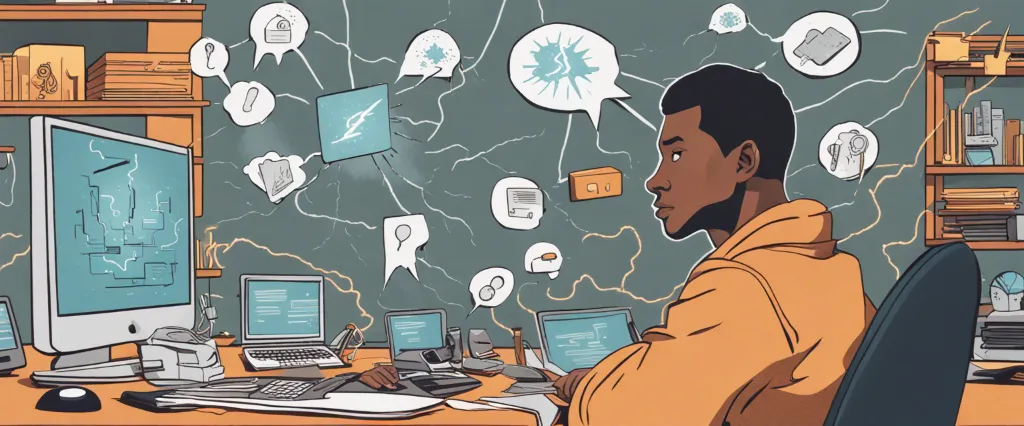In the thought-provoking book “Irresistible,” Adam Alter explores the alarming prevalence of addiction in today’s digital age. Shedding light on the powerful psychological and neuroscientific forces behind our compulsion to engage with technology, Alter investigates how design techniques employed by technology companies have woven addiction into the very fabric of our daily lives. As a renowned professor of marketing and psychology at New York University’s Stern School of Business, Alter brings a unique blend of academic rigor and real-world insights to tackle the growing concern surrounding our incessant screen time and its consequences. In “Irresistible,” he unearths the mechanisms that have made our devices and online platforms so irresistible, providing crucial knowledge to better understand and navigate the addictive nature of our digitally saturated world.
Chapter 1: The Rise of Behavioral Addiction
Chapter 1 of “Irresistible” by Adam Alter, titled “The Rise of Behavioral Addiction,” introduces the concept of behavioral addiction and explores its growing prevalence in today’s society. Alter argues that modern technologies, particularly smartphones and social media platforms, have been designed to capture and hold our attention in ways that can lead to addictive behaviors.
The chapter begins by highlighting the addictive nature of digital technology and how certain individuals are more susceptible to its allure. Alter describes how notifications, likes, and messages play on our innate desire for social rewards, leading to a constant need for engagement and validation. He introduces the term “behavioral addiction” to describe this phenomenon, differentiating it from substance addiction by focusing on the compulsive engagement with rewarding behaviors, rather than substances.
Alter delves into the persuasive techniques employed by technology companies to make their products addictive. He discusses the concept of “variable rewards,” where users are rewarded intermittently, which fuels our desire to seek further engagement. He also explores the concept of “bottomless bowls,” referring to how apps and social media platforms offer an endless stream of content tailored to individual preferences, making it challenging to disengage.
Moreover, Alter highlights the detrimental consequences of behavioral addiction. He examines the impact of excessive screen time on mental health, sleep patterns, and relationships, citing numerous research studies that demonstrate these negative effects.
Overall, Chapter 1 of “Irresistible” sets the stage for the exploration of behavioral addiction in the modern world, highlighting its prevalence and the powerful techniques used to make technology inherently enticing and potentially addictive.
Chapter 2: The Hooked Model
Chapter 2 of “Irresistible” by Adam Alter delves into the “Hooked Model,” which is an influential framework used by tech companies to create and maintain addictive products. Alter begins by discussing the success of social media platforms like Facebook, Twitter, and Instagram, emphasizing their ability to keep users engaged for extended periods and trigger a near-compulsive need to constantly check for updates.
The Hooked Model consists of four key stages: trigger, action, variable reward, and investment. The trigger is the cue that prompts a user to engage with a product, often involving external stimuli like push notifications. Actions refer to the user’s behavior, such as scrolling, liking, or sharing. Variable rewards are the unpredictable elements that maintain interest, ranging from receiving likes on a post to discovering new content. Finally, investment involves actions that increase the user’s commitment to the platform, such as accruing followers or personalizing profiles.
Alter highlights the role of technology in shaping variable rewards by leveraging psychological concepts, such as intermittent reinforcement and social validation. Intermittent reinforcement, referring to the occasional and unpredictable rewarding of users’ actions, keeps them engaged by creating anticipation and a desire for more. Social validation, on the other hand, taps into humans’ inherent need for acceptance, recognition, and comparison by prompting users to seek validation through likes, comments, and followers.
Furthermore, the author explains the importance of investment, as it strengthens users’ commitment to the platform and creates a sense of obligation or loss aversion. By investing time, effort, information, or money into a product, individuals become more likely to continue using it to justify their previous investments.
In summary, Chapter 2 of “Irresistible” explores the Hooked Model used by tech companies to develop and maintain addictive products. By capitalizing on triggers, actions, variable rewards, and investments, these companies keep users constantly engaged and hooked, fostering the addictive nature of modern technologies.
Chapter 3: The Allure of Social Media
Chapter 3 of “Irresistible” by Adam Alter, titled “The Allure of Social Media,” delves into the addictive and captivating nature of social media platforms. Alter explores the psychological and behavioral factors that make these platforms so compelling, highlighting their ability to provide immediate feedback and gratification, foster social connection, and exploit human vulnerabilities.
The chapter starts by introducing the concept of intermittent reinforcement, which plays a crucial role in the addictive nature of social media. Alter explains that these platforms are designed to provide unpredictable rewards, such as notifications, likes, and comments, which create a powerful craving for more. This reinforcement mechanism taps into our brain’s dopamine system, leading to increased engagement and repetitive use.
Furthermore, Alter explores the concept of the “ideal self” that social media promotes. Users tend to carefully curate their profiles to present an enhanced version of themselves, leading to social comparison and potentially negative emotions. This constant comparison trap fuels the desire for validation and social acceptance, further contributing to the allure of social media.
The author also discusses how social media platforms are highly effective at exploiting psychological vulnerabilities, employing features such as infinite scrolling and autoplay to keep users engaged for prolonged periods. Additionally, Alter raises concerns about the impact of social media on mental health, highlighting the correlation between high social media use and increased rates of anxiety, depression, and body dissatisfaction.
Overall, Chapter 3 highlights the irresistible allure of social media by examining its addictive qualities, capacity to gratify our needs for social connection and validation, and exploitation of psychological vulnerabilities. Alter emphasizes the importance of understanding these dynamics and developing strategies to maintain a healthy relationship with social media.
Chapter 4: The Rise of Online Gaming

Chapter 4 of “Irresistible” by Adam Alter explores the phenomenon of online gaming and its unprecedented growth in popularity. The chapter sheds light on the captivating nature of these games, their immersive qualities, and the potential drawbacks associated with their rise.
Alter begins by delving into the allure of multiplayer online games, highlighting their ability to create engaging social experiences. He discusses the concept of “flow,” where players become fully engrossed in the virtual world, losing track of time and becoming emotionally invested in the game’s challenges and rewards. Online gaming offers a constant stream of interactive experiences, bridging the gap between reality and the virtual world.
However, Alter also points out the negative consequences that can arise from excessive online gaming. He explores the addictive nature of these games, where users can become consumed by the need for achievement and recognition within the virtual ecosystems created by game developers. In some cases, individuals may neglect their real-life responsibilities, relationships, and mental well-being due to their intense dedication to online gaming.
Alter delves into the techniques employed by game designers to maximize engagement and monetary gain. Frequent updates, rewards systems, and social pressure to keep up with one’s peers contribute to the addictive nature of online games, ensuring that players are constantly coming back for more.
Overall, Chapter 4 of “Irresistible” outlines the rise of online gaming as a captivating and immersive activity, highlighting both its positive social aspects and potential negative consequences. Alter encourages readers to approach the world of online gaming with caution, recognizing the balance needed in order to prevent excessive use from interfering with other important aspects of life.
Chapter 5: The Power of Screens
Chapter 5 of “Irresistible” by Adam Alter explores the power of screens and their impact on our lives. Alter begins by discussing the rise of television in the 20th century, emphasizing how screens gradually transitioned from being a luxury to a necessity in our daily routines. With the arrival of smartphones and other portable devices, screens have become ever more prevalent, creating a ubiquitous and addictive presence in our lives.
Alter dives into the concept of “technoference,” which refers to the intrusion of screens into face-to-face interactions. He highlights the negative consequences of this phenomenon, such as lower quality conversations, reduced empathy, and increased distractions. Alter argues that the constant presence of screens affects our overall well-being, leading to decreased happiness and life satisfaction.
The author explores how screens and social media exploit our psychological vulnerabilities, particularly the phenomena of continuous partial attention and fear of missing out (FOMO). These elements intensify the addictive nature of screens, as we constantly feel the need to check our devices, fearing that we might be left out or miss out on something important.
Alter delves into the science behind screen addiction, emphasizing how the pleasure cycle—triggered by notifications, likes, and scrolling—reinforces our dependency on screens. He discusses the role of dopamine, a neurotransmitter associated with pleasure and reward, in this addictive process.
Furthermore, Alter examines the gaming industry and its manipulation of psychological triggers to keep users engaged for longer periods. He explains how the design of games, specifically the use of variable rewards, triggers the release of dopamine and hooks players into addictive cycles.
Overall, Chapter 5 delves into the power of screens and their implications on our lives, shedding light on the psychological mechanisms that make screens so appealing and addictive.
Chapter 6: Escaping the Irresistible
Chapter 6 of “Irresistible” by Adam Alter is titled “Escaping the Irresistible.” In this chapter, the author explores the ways in which individuals can break free from the addictive allure of technology and take back control of their lives.
Alter starts by discussing the concept of “boredom,” which has become increasingly rare in the digital age. Boredom, he argues, is essential for creativity and self-reflection. However, with constant access to smartphones and other devices, individuals rarely experience true boredom as they are always entertained or distracted. Alter emphasizes the importance of embracing moments of boredom and allowing the mind to wander, as this can lead to new ideas and personal growth.
The author then introduces the concept of “digital fasting” or taking extended breaks from technology. He presents several studies that highlight the benefits of short-term digital detoxes, such as decreased stress levels and increased focus. Alter recommends implementing technology-free zones or regularly scheduled breaks to regain control over our tech habits.
Understanding the power of habit formation, Alter also suggests the importance of replacing unhealthy tech habits with healthier alternatives. He suggests engaging in activities that encourage face-to-face interactions, physical exercise, and hobbies that promote mindfulness and relaxation.
Additionally, the chapter delves into effective strategies for managing email addiction. Alter provides practical tips such as setting designated email-checking times, unsubscribing from unnecessary mailing lists, and adopting email filtering systems to regain control over the overwhelming influx of messages.
In conclusion, Chapter 6 of “Irresistible” focuses on the importance of cultivating a healthier relationship with technology. It emphasizes the need for embracing boredom, taking breaks from technology, developing alternative habits, and managing digital communication effectively. By implementing these strategies, individuals can regain control over their lives and overcome the irresistible allure of technology.
Chapter 7: The Future of Behavioral Addiction
Chapter 7: The Future of Behavioral Addiction, from Adam Alter’s book “Irresistible,” explores the potential trajectory of addiction to behavioral stimuli in the modern era. Alter highlights how technology has become increasingly addictive, with social media platforms, video games, and other digital experiences designed to captivate users and keep them coming back for more.
The chapter starts by discussing a phenomenon called “variable rewards,” a strategy employed by many addictive technologies. This refers to the intermittent and unexpected nature of rewards, which keeps users engaged and craving more. Alter argues that tech companies deliberately exploit this trick to manipulate user behavior and create habitual patterns of interaction.
Next, the author delves into the rise of immersive technologies such as virtual reality (VR). Alter explains how VR can create mesmerizing and addictive experiences, blurring the line between the digital and physical worlds. He mentions the potential dangers of excessive VR usage, emphasizing that some individuals might become so engrossed in their virtual reality that they neglect their real-life responsibilities.
Additionally, Alter explores the concept of “persuasive technology,” which uses behavioral psychology principles to influence user behavior. Tech companies often employ this strategy to create technologies that are difficult to resist, including notification systems that trigger the release of dopamine in users’ brains. The chapter highlights how these techniques can lead to addictive behaviors and raises concern about the ethical implications of manipulating individuals for profit.
The chapter concludes by addressing the future of behavioral addiction. Alter suggests that as technology continues to advance, addiction to behavioral stimuli may become more prevalent. He predicts the emergence of new addictive technologies, such as augmented reality (AR) and neuro-hacking devices, that will further challenge society’s ability to regulate and manage addiction.
In summary, Chapter 7 of “Irresistible” highlights the increasing problem of behavioral addiction fueled by addictive technologies. Alter emphasizes the role of variable rewards, immersive technologies like VR, and persuasive techniques employed by tech companies to create addictive experiences. The future of behavioral addiction is predicted to grow with advancements in technology, raising concerns about its impact on individuals and society as a whole.

Chapter 8: Reclaiming Our Lives
Chapter 8: Reclaiming Our Lives of the book “Irresistible” by Adam Alter explores strategies to regain control of our lives and redirect our attention towards more meaningful things in the midst of a technology-driven world. The chapter emphasizes the importance of breaking the addictive hold that technology has on our habits, relationships, and overall well-being.
Alter introduces the concept of “time well spent,” which encompasses the idea of consciously allocating our time and attention to activities that truly matter to us. He shares examples of individuals who were able to curb their technology addiction by implementing strategies such as turning off notifications, setting specific technology usage times, and customizing their digital environments to reduce distractions.
The chapter also delves into the power of forming new habits and replacing technology use with more productive and fulfilling activities. Alter suggests starting with small achievable goals and gradually increasing the difficulty to create sustainable change. He explores the benefits of engaging in activities that involve face-to-face social interactions, nature, and physical exercise, as these experiences have been shown to boost happiness and well-being.
Furthermore, Alter highlights the significance of setting boundaries with technology in our personal relationships, especially when it comes to spending quality time with loved ones. He encourages practicing mindfulness, being fully present, and avoiding technological distractions during social interactions to deepen connections and foster genuine relationships.
The chapter concludes with a call to action, urging individuals to take charge of their technological habits and consciously use technology as a tool to enhance their lives, rather than allowing it to control and consume their time and attention. By reclaiming our lives, focusing on meaningful activities, and cultivating genuine connections, we can strike a balance between technology and the pursuits that truly bring us joy and fulfillment.
After Reading
In his book “Irresistible,” Adam Alter shines a critical light on the impact of technology and its addictive qualities in our daily lives. He explores the ways in which our reliance on devices, social media, and gaming have reshaped our behavior, relationships, and overall well-being. By examining psychological studies, interviews, and personal anecdotes, Alter reveals the powerful techniques employed by tech companies to keep us hooked and how these behaviors have become normalized in society. Ultimately, Alter warns of the detrimental effects this addiction can have on our mental health, productivity, and social connections. He proposes strategies for individuals and society as a whole to regain control over their digital lives and establish a healthier relationship with technology. “Irresistible” serves as a wake-up call to reevaluate our reliance on screens and reminds us to prioritize our well-being in a world that is increasingly hard to resist.
1. Hooked: How to Build Habit-Forming Products” by Nir Eyal
In a similar vein to “Irresistible,” “Hooked” explores the psychology behind why certain products become addictive and how companies use behavioral patterns to keep users engaged. Eyal provides practical insights and techniques for creating habit-forming products and offers critical analysis of the ethical implications behind this phenomenon.
2. Digital Minimalism: Choosing a Focused Life in a Noisy World” by Cal Newport
For those seeking strategies to resist the overwhelming pull of digital distractions, “Digital Minimalism” is an insightful read. Newport explores the adverse effects of excessive technology use and provides a step-by-step guide on how to establish a healthier and more intentional relationship with your digital devices.
3. The Shallows: What the Internet Is Doing to Our Brains” by Nicholas Carr
In this thought-provoking book, Carr delves into the cognitive changes caused by our constant exposure to online information. With compelling research and personal anecdotes, he argues that the internet is rewiring our brains, prioritizing the shallow processing of information at the expense of deep contemplation and intellectual development.
4. “Distracted: The Erosion of Attention and the Coming Dark Age” by Maggie Jackson
“Distracted” examines the wide-ranging impact of our increasingly distracted society on individuals and communities. Jackson explores the historical, technological, and cultural factors that have contributed to our diminishing attention spans and provides practical advice for reclaiming focus, concentration, and a sense of deep connection to the world around us.
5. “The Art of Choosing” by Sheena Iyengar
For those interested in the intricacies of decision-making, “The Art of Choosing” offers a fascinating exploration. Iyengar delves into the myriad factors that influence our choices, from culture and personal values to the overwhelming abundance of options in our modern world. By understanding how choice is presented and how we respond to it, readers can gain more insight into their own decision-making processes and how these processes can be manipulated.




